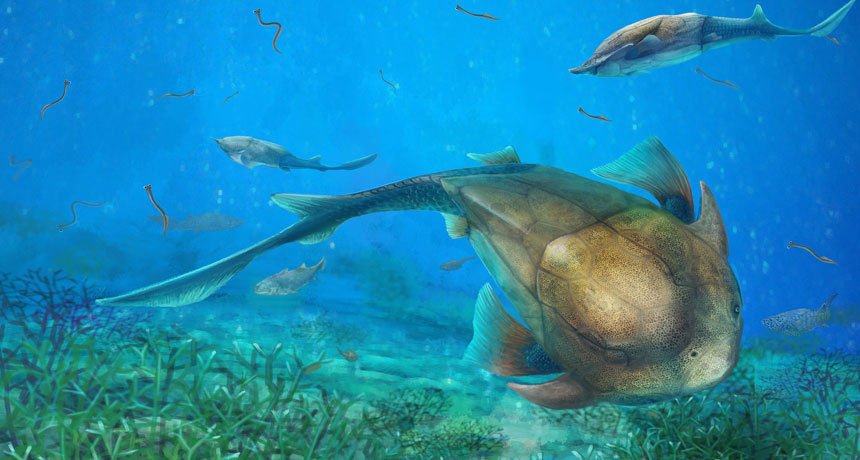Ancient armored fish revises early history of jaws
Placoderm fossil had skull bones like those of many modern vertebrates

FISHFACE A 423-million-year-old armored fish from China had jaws that resemble those of modern land vertebrates and bony fish.
Dinghua Yang
A freaky fish with a head like a dolphin and a body like a tank may be to thank for human jaws.
The discovery of a 423-million-year-old armored fish from China suggests that the jaws of all modern land vertebrates and bony fish originated in a bizarre group of animals called placoderms, researchers report in the Oct. 21 Science.
Along with a different placoderm fossil from 2013, the new find, named Qilinyu rostrata, is helping rewrite the story of early vertebrate evolution, says paleontologist John Maisey of the American Museum of Natural History in New York City, who was not involved with the work.
“We’ve suddenly realized we had it all wrong,” he says.
The jaws of humans — and dogs, salmon, lizards and all other bony vertebrates — contain three key bones: the maxilla and premaxilla of the upper jaw, and the dentary of the lower jaw.
“Anything from a human being to a cod has recognizably the same set of bones in the head,” says study coauthor Per Ahlberg, a paleontologist at Uppsala University in Sweden. The big question, he says, is “Where did these bony jaws come from?”
More than a hundred million years before dinosaurs walked the Earth, fishes called placoderms thrived under water. Scientists knew that these armored fishes were early jawed animals, but their jaws were unusual: “They look like sheet metal cutters,” Ahlberg says. “They’re these horrible bony blades that slice together.”

Placoderms are a highly debated group of animals, says paleontologist Martin Brazeau of Imperial College London. No one quite knew where to place them.
In 2013, Ahlberg and colleagues found a new clue in a 419-million-year old fossil that had the body of a placoderm, but the three-part jaw of a bony fish. Such an animal, called Entelognathus primordialis, “could never have been predicted from the fossil record,” says paleontologist Gavin Young of Australian National University in Canberra.
That work bolstered the idea that placoderms weren’t, in fact, their own odd group that dead-ended hundreds of millions of years ago — some were actually the ancestors of bony fish (and thus humans). But it was just one fossil, Ahlberg notes. “You don’t want to draw too big of conclusions from one animal.”
Two animals, though, is a different story. Qilinyu, the new fossil Ahlberg and colleagues describe, had an armored skull and trunk and was probably about the length of a box of tissues. Like Entelognathus, Qilinyu has a three-part, bony fish–like jaw, though the creature looks a bit more like a typical placoderm, Ahlberg says. The two fossils “form almost perfect intermediates” between placoderms and bony fishes, he says. Ahlberg and his colleagues suspect the key jaw elements of bony fish (and all land vertebrates) evolved from those bony blades of placoderms.
“This is part of our own early evolutionary history,” Ahlberg says. “It shows where our own jaws came from.”
Maisey puts it another way: “We are all fundamentally placoderms.”







